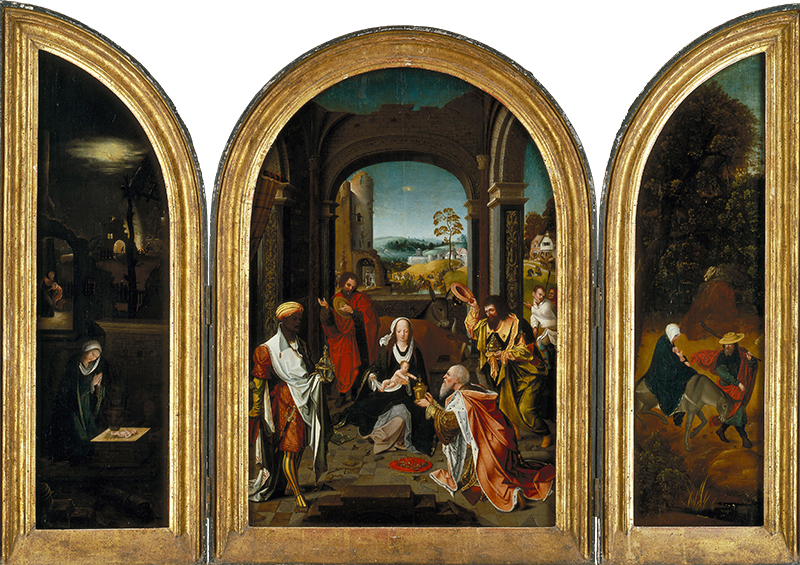An Altarpiece for Bowdoin: New Acquisition Offers Insights into Early Modern Culture, Trade, and Diversity
By Bowdoin College Museum of ArtThe Bowdoin College Museum of Art recently acquired its first multi-panel altarpiece, a triptych created in the workshop of the Antwerp artist Jan de Beer around 1518–19. Painted in luminous oil colors on oak panels, the work describes in engaging detail the The Adoration of the Magi, framed by renditions of The Nativity at Night, with The Annunciation to the Shepherds (left panel), and The Flight into Egypt (right panel). Visitors to the Museum’s gallery of historic European art have been admiring the work since late June, when it came to Brunswick as a loan from a private collection in London. We are pleased to announce the purchase of the triptych with funds provided by Museum acquisition endowments.

While many viewers here in New England might be familiar with the Christmas-themed narrative of the panels, they will be surprised to discover how much information about early modern Europe is woven into it. Consider, for example, the role of the three magi as personifications of the three continents known at the time, including a black magus representing “Africa.” Recent scholarship has pointed out that such depictions of Africans reflect a much more diverse society in late medieval and early modern Europe than previous generations of historians have acknowledged. Furthermore, the arrival of the magi from all over the known world held special interest for Antwerp collectors since they, too, engaged in international trade during this early phase of “globalization.”
For art historians, the altarpiece exemplifies an important type of image that was central to devotional art in Christian Europe over many centuries. While the Museum has a fine examples from the Italian Renaissance—thanks to a donation from the Kress Foundation in 1961—we have fewer Northern Renaissance paintings. This beautifully painted and well-preserved altarpiece provides the desired opportunities for teaching and research and ideally complements the Museum’s existing holdings. It is also a beautiful work of art to encounter in the galleries that will enrich our visitors’ experience, regardless of their prior knowledge and background.
According to new scholarship by art historian Dan Ewing of Barry University, Bowdoin’s adoration altarpiece was executed by workshop assistants in the studio of Jan de Beer, a major figure of Northern Renaissance art. It is similar to another version of this triptych in the Alte Pinakothek, Munich. The two works were most likely painted side-by-side. It is often difficult to identify artists of early modern paintings, because they worked in larger workshops for a market that had not yet developed a taste for “originality.” Jan de Beer is first mentioned as an apprentice to Gillis van Everen (active 1477–1513) in the records of the Guild of Saint Luke in Antwerp. He became a master in 1504 and later took on administrative duties in the Guild. Only one signed work by de Beer is known to exist, a drawing at the British Museum. A century of scholarship has established a corpus of attributed works.
We invite you to learn more about this important work and about other new acquisitions on December 11, 2018, at 5:00 pm. At our “Members’ Evening at the Museum,” enjoy the company of fellow members, and discuss with the Museum’s curatorial team this and other new additions to the collection.
Joachim Homann, Curator
Bowdoin College Museum of Art